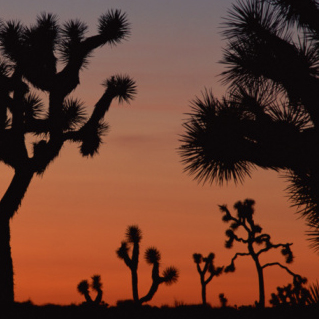It’s not time to rename Joshua Tree just yet, says the author of a new study.
Climate change is threatening the Joshua trees in Joshua Tree National Park all right, according to a new report. But unlike the findings of recently-published study, this report finds the park’s iconic, spiky namesake is unlikely to completely vacate the premises over the next century.
The new report was funded in part by Joshua Tree National Park, and its author Cameron Barrows, a researcher at UC Riverside’s Center for Conservation Biology, says that he conducted it partly in response to the recent study by Ken Cole of the USGS, which found that the trees would likely be gone from the park within the next 90 years.
“I facetiously say if that was to happen, we’d have to rename the park ‘Creosote Bush National Park’ or something like that,” said Barrows. “It would be really sad if that’s the case.”
Barrows’s study looked up-close at the park itself, rather than the entire Joshua tree range, using both computer models and on-the-ground fieldwork. He says that there are pockets of the park, at high elevations and in shaded canyons, where the trees could persist even in the face of significant environmental changes.
“If you look at it from the satellite view, you’re going to lose them,” he said. “But if you’re standing on the ground and looking at these canyons and the very diverse topography of the park, there are places where it looks like the trees will be able to maintain themselves.”
Barrows projects that a 3-4 degree F rise in temperature would shrink the range of Joshua trees in park substantially at lower elevations, but that they’d continue to thrive in higher elevation areas of the park. With a increase of more than 5 degrees, however, he said, the area where the trees could persist shrinks to the size of “about a couple of football fields.”
In the last decade, he said, temperatures in the park have increased close to 2 degrees F. To test the effects of this warming, Barrows said he sent out teams of citizen scientists with the mission to find the smallest (and therefore youngest) Joshua trees they could. This way, he could analyze where the trees have been reproducing over the last decade
“We found, in fact, that we’re already seeing the signature of climate change,” he said. “The distribution of the young trees is much smaller than that of the adult trees. There’s no Joshua tree reproduction occurring right along the southern edge of its current distribution.”
The story is not just one of temperature. According to Barrows, precipitation plays an even more important role in the survival of Joshua trees. And precipitation is one of climate change’s great wild cards.
“The climate models are really pretty robust when it comes to temperature, but they are really not robust at all – the opposite of robust, really – when it comes to precipitation,” said Barrows. “The only thing they agree on is its going to get more variable.”
He said the last decade has seen four of the park’s six wettest years and two of the park’s driest. He takes that high variability as an indication that the park is likely already seeing the effects of climate change.
“What is going to kill the baby Joshua trees are these pulses of droughts,” he said.
But with increasing variability, those dry years could likely be followed by some wet ones, when reproduction could occur again, he said.
Even so, it seems that increased variability could make adolescence harder on Joshua trees than it was for their ancestors: Barrows says it takes between 50 and 100 years for a Joshua tree to reach reproductive age.

